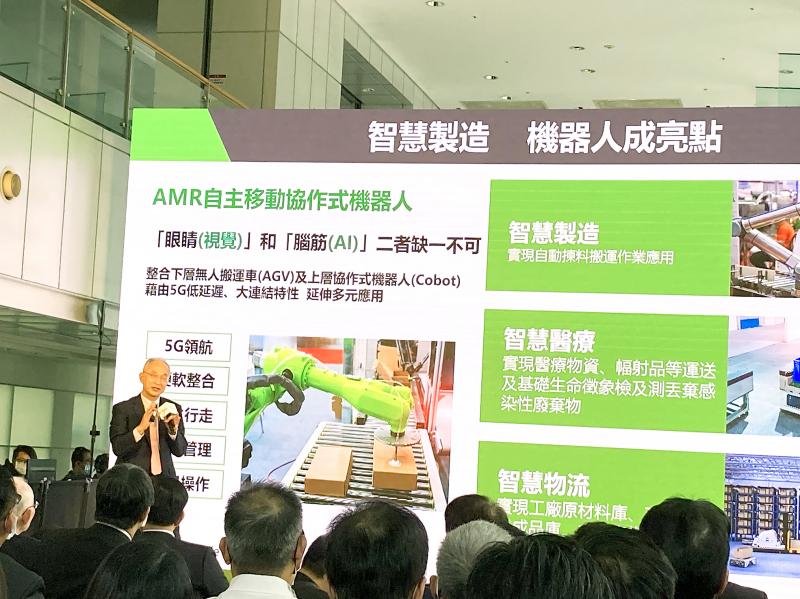Asia Pacific Telecom Co (APT, 亞太電信) yesterday said it aims to turn a profit in the next three to five years by boosting revenue contribution from enterprise customers, which deliver better margins and are keen to adopt ultrahigh-speed and low-latency 5G services.
APT made the remarks after launching its 5G services on 3.5-gigahertz and millimeter-wave on the 28-gigahertz band, with the latter better suited to building private networks for local enterprises.
APT, 40 percent owned by Hon Hai Precision Industry Co (鴻海精密), is the sole domestic telecom to secure a spectrum license to build 5G networks on 28-gigahertz band.

Photo: Lisa Wang, Taipei Times
The telecom depends heavily on retail consumers to generate revenue, who account for 70 percent of its base, while enterprise customers make up just 30 percent, company president Huang Nan-ren (黃南仁) told a media briefing in Taipei.
With more 5G applications coming on-line, APT aims to boost enterprise customers’ contribution to half of its revenue within the next three to five years, Huang said.
“Enterprise customers deliver better margins and would help narrow our losses,” Huang said.
It is the company’s goal to reduce its losses by between NT$500 million and NT$1 billion (US$17.3 million and US$34.6 million) a year, he said.
APT has also set an internal target to convert 10 to 12 percent of its 4G subscribers to 5G services within the first year of their launch, Huang said.
The company saw losses widen to NT$2.9 billion in the first half of this year, from a loss of NT$2.6 billion in the same period last year.
As part of its turnaround efforts, APT yesterday unveiled its 5G tariffs, ranging from NT$599 to a flat rate starting at NT$1,399 a month, similar to the offerings by the nation’s big three telecoms.
It was a marked difference from its previous strategy of undercutting the competition to attract price-sensitive users.
“The prices reflect our improvement on Internet connection quality, as well as our brand equity,” Huang said. “Our marketing team will adjust our pricing strategy according to the market situation. Pricing will be dynamic.”
Huang dismissed speculation that APT is under pressure from Far EasTone Telecommunications Co (遠傳電信) to raise 5G tariffs as it is leasing the company’s 3.5G-band spectrum.
Far EasTone last month said that it planned to acquire an 11.58 percent stake in APT for NT$5 billion at the most, in the first phase of its broader plan to deepen their partnership to trim heavy 5G deployment costs via spectrum sharing.
The deal would give APT much-needed access to Far EasTone’s 3.5G 5G spectrum for 20 years.
APT also agreed to pay an extra NT$9.47 billion for using the spectrum, as well as sharing about 22 percent of the network deployment costs.
The company added that it plans to raise NT$17.5 billion through private placements.
Hon Hai is expected to invest NT$10 billion and Far EasTone to invest NT$5 billion, APT said, with the remainder coming from its 5G supply chain, the company said.

TECH BOOST: New TSMC wafer fabs in Arizona are to dramatically improve US advanced chip production, a report by market research firm TrendForce said With Taiwan Semiconductor Manufacturing Co (TSMC, 台積電) pouring large funds into Arizona, the US is expected to see an improvement in its status to become the second-largest maker of advanced semiconductors in 2027, Taipei-based market researcher TrendForce Corp (集邦科技) said in a report last week. TrendForce estimates the US would account for a 21 percent share in the global advanced integrated circuit (IC) production market by 2027, sharply up from the current 9 percent, as TSMC is investing US$65 billion to build three wafer fabs in Arizona, the report said. TrendForce defined the advanced chipmaking processes as the 7-nanometer process or more

China’s Huawei Technologies Co (華為) plans to start mass-producing its most advanced artificial intelligence (AI) chip in the first quarter of next year, even as it struggles to make enough chips due to US restrictions, two people familiar with the matter said. The telecoms conglomerate has sent samples of the Ascend 910C — its newest chip, meant to rival those made by US chipmaker Nvidia Corp — to some technology firms and started taking orders, the sources told Reuters. The 910C is being made by top Chinese contract chipmaker Semiconductor Manufacturing International Corp (SMIC, 中芯) on its N+2 process, but a lack

Who would not want a social media audience that grows without new content? During the three years she paused production of her short do-it-yourself (DIY) farmer’s lifestyle videos, Chinese vlogger Li Ziqi (李子柒), 34, has seen her YouTube subscribers increase to 20.2 million from about 14 million. While YouTube is banned in China, her fan base there — although not the size of YouTube’s MrBeast, who has 330 million subscribers — is close to 100 million across the country’s social media platforms Douyin (抖音), Sina Weibo (新浪微博) and Xiaohongshu (小紅書). When Li finally released new videos last week — ending what has

NVIDIA PLATFORM: Hon Hai’s Mexican facility is to begin production early next year and a Taiwan site is to enter production next month, Nvidia wrote on its blog Hon Hai Precision Industry Co (鴻海精密), the world’s biggest electronics manufacturer, yesterday said it is expanding production capacity of artificial intelligence (AI) servers based on Nvidia Corp’s Blackwell chips in Taiwan, the US and Mexico to cope with rising demand. Hon Hai’s new AI-enabled factories are to use Nvidia’s Omnivores platform to create 3D digital twins to plan and simulate automated production lines at a factory in Hsinchu, the company said in a statement. Nvidia’s Omnivores platform is for developing industrial AI simulation applications and helps bring facilities online faster. Hon Hai’s Mexican facility is to begin production early next year and the